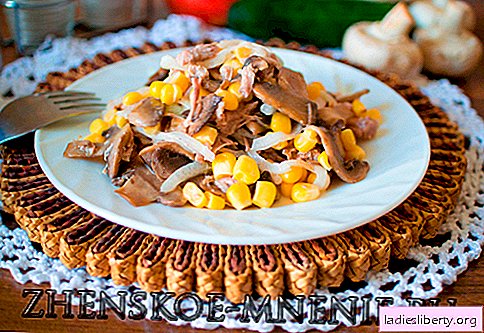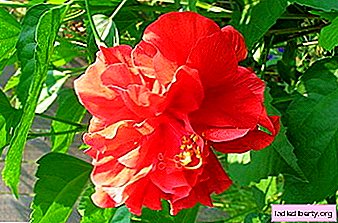
Jerusalem artichoke - a relative of sunflower, came to us from North America.
This is a perennial culture with thin and tall stems and rough leaves.
On the roots of the plant there are oblong tubers that grow until late autumn and are ready to be harvested after the first frost.
Externally, the tubers of this culture are similar to ginger root.
They are healing for the body and tasty. The green mass of the Jerusalem artichoke well maintains low temperatures, the tubers are perfectly preserved in the soil until spring, for this reason even in the northern regions of the country it can be harvested both in autumn and spring, and in the south harvesting is possible all winter.
Jerusalem artichoke: cultivation. Selection of planting material, variety
This crop has many different varieties, more than 300 are known, depending on the purpose of the tubers, you can choose the most suitable variety for your needs. But in practice, planting tubers obtained from other amateurs are most often used for reproduction.

General form
Varieties according to the ratio of the weight of tubers to the yield of the vegetative mass are divided into 3 groups:
1. Tuberous varieties, planted for technical purposes, in the general harvest the mass of tubers reaches 45%;
2. Silage varieties, plants with a large amount of greenery, the mass of which reaches 70%;
3. Tubers - silage varieties, giving a lot of both greens and tubers, they are grown most often.
Depending on the length of the growing season, varieties are divided into:
• Early:
• Mid-season;
• Late.
The duration of the growing season within 120-200 days.
The most common varieties of Jerusalem artichoke
• Early on - a tuberous variety, forms many tubers, the bush grows up to 2 m, abundantly blooms, decorative. Tubers hibernate well in the soil, by the spring they increase the sugar content;
• Interest - tuberous high-yielding variety, the plant grows up to 2.5 m;
• Vadim - gives smooth tubers of reddish color, leveled, of medium size, perfectly stored as sand and in the soil poured in the cellar. Bush with large leaves of dark green color;
• Hungarian - silage variety, gives a large amount of green mass, tubers grow little. Plant height up to 5 m, with a large number of large leaves, grows well in the shade;
• Interest - late-ripening variety, which has a light brown tuber, with slightly sunken eyes. The stem is well branched, powerful, the length of the main root reaches 2 meters. The variety does not have time to ripen in the northern regions of the country; it fully matured only by November;
• News - the plant with a branching stem is erect, the leaves are dark green, oval, white tuber, from 10 m2 you can collect up to 40 kg of root crops;
• Tolipolis - high-yielding hybrid of sunflower and topinabur.
Jerusalem artichoke: cultivation. Planting, site selection (timing, feeding, shelter, temperature, soil, etc.)
It is best to plant a Jerusalem artichoke after perennial and annual legumes. Stable yields are yielded by perennial cultivation of a variety with small stolons. You can not create a plantation of Jerusalem artichoke in the area where before this root, sunflower and plants that are affected by sclerotinia grew. It is convenient to place this culture near the pigsty, to subsequently produce pigs for grazing in this area.
Processing soil for Jerusalem artichoke is almost the same as preparing the soil for other roots and potatoes. After the peeling of the site, the zyablyuyu treatment to a depth of more than 20 cm is performed, after the snow melts as the ground ripens, the plowing is plowed. Immediately before planting the Jerusalem artichoke cultivated area.
About 300 kg of manure or other organic matter are weaved into the soil, fertilizers containing potassium and phosphorus (in areas with high acidity and lime) are added during autumn plowing, nitrogen fertilizers - cultivation or plowing of the area in spring time. In subsequent seasons, the site is fertilized with mineral mixtures, if the Jerusalem artichoke is grown without changing places for 8-12 years, then fertilizer is repeated with organic matter every 4-5 years.
Usually, this crop is planted in spring, in the south, on light soils, Jerusalem artichokes can be planted in the fall. Landing in the spring as soon as possible at the same time as early spring. The delay in planting will negatively affect the yield of greens and tubers of this crop.
Planting is carried out in a wide-row manner with a spacing of 60-70 cm between rows, between individual plants in a row, left between 30-60 cm. In areas with frequent rains and fertile soil, tubers are planted thicker. If you have a branchy variety, then the distance between the bushes makes more. When planting small tubers, they need to be planted thicker, which allows you to get the same harvest as a topinambur planting, tubers of normal size.
Tubers for the device of the Jerusalem artichoke plantation are dug before planting on the site. If the planting is not carried out immediately, the tubers can be saved by filling them with sand or soil, so that they do not wilt. If the tubers are turned out, they must be kept for 1-1.5 days, kept in plain water, which will restore their normal condition.
Tubers should be planted on medium-sized soils no more than 8 cm deeper, and on light soils no deeper than 10 cm, during autumn planting, the tubers are buried 2-3 cm deeper into the soil. The eyes on the planting material of Jerusalem artichoke begin to grow at a temperature of 5-6 degrees, harmonious germination is possible only when the temperature rises above 8 degrees. Seedlings will make their way to the soil surface only in 20-30 days, for this reason, to control weeds before the emergence of seedlings, the area is harrowed several times. After the plants rise by 10-15 cm, they conduct inter-row processing, and the bushes that grow to 40 cm are spud.
If you have to plant this crop in a poorly cultivated area, do not be upset that you will need to fight hard against weeds, as soon as the bushes grow above 0.5 m, the weeds will be unable to compete with it. In areas where the Jerusalem artichoke grows for several years, the most time-consuming task of care is thinning. In a crop rotation, it is better not to use this plant, after it there are a lot of small nodules in the soil, which are able to choke any vegetable crop. Only the extermination of each sprout appeared, allows you to bring this plant, you can destroy a small growth with herbicides.
Jerusalem artichoke: cultivation. Care, feeding
This culture forms just a huge mass of greenery, it is best suited for a plot with fertile soil, and for obtaining a large number of tubers it is necessary to prepare a loose soil. Best of all, for planting plants use light, well-filled with organic loam. Optimal for growing regions with a temperate climate. It is advisable to choose for a plantation of Jerusalem artichoke a place well lit by the sun, in a pinch, a slightly shaded area will suit. Since this is a perennial plant with a high ability to recover, in the area near the house you can sometimes break in the bushes and choose large tubers, so you do not have to transplant the plant to another location every year.

Fertilizer
German scientists have found that potassium in this plant increased demands. As for nitrogen, the tips here are different, it is recommended to make this element on the active substance in the range of 50-150 grams. per hundred. The main time of tubers is July - September (in the southern regions until October).
Harvesting tubers
Harvest of Jerusalem artichoke gradually increases until the formation of tubers. But early to mow it is undesirable, since this will significantly reduce the total mass of tubers. In the south, green mass is removed not earlier than in October, in the north-western region in the last decade of September, in the north no later than the beginning of September.

Harvesting Jerusalem artichoke
Cut off the greens of this culture, preferably high, not lower than 30 cm as a result of the outflow of plastic substances from the low-value part of the stem, the weight of the tubers remaining in the soil increases significantly. When pigs are kept in early spring, they are grazed on the topinambur plantations for two weeks. After harvesting, root crops are cultivated and harrowed with the site, followed by harvest, remaining on the surface of tubers.
Sprouts on the site after cultivation of Jerusalem artichoke, can be destroyed as follows:
• By mowing the seedlings during the period when new tubers have not yet begun to form, and nutrients from last year’s tubers, that is, in the last decade of June, have been consumed, followed by digging up the site and planting early ripening crops;
• Growing silage at the feed area.
These methods allow you to almost completely clean the area from tubers.
Topinambur storage
Before laying the tubers for storage, you need to decide on the date of harvest. It is best to clean the tubers in the spring, so you can almost completely retain all the nutrients. Leaving Jerusalem artichoke under the winter, the stems are completely cut off, not worth it. Jerusalem artichoke ideally preserved in regions where the soil does not freeze or freeze for a short time, in which case it can be removed during the entire winter period. Pledged in storage tubers are stored much worse than potatoes. In areas with a long frost period, it is possible to increase the time of harvest by sprinkling straw on the plot.
The main pests and how to deal with them
In contrast to other cultures, Jerusalem artichoke has almost no diseases and pests. Tubers of plants can damage a little caterpillars scoop, wireworms and medvedki.
Sometimes at the end of the season you can find on plants alternarioz and real powdery mildew, but the lesions are not critical, and simple precautions are enough to control - the destruction of diseased plants and the planting of Jerusalem artichoke in another area.
And in the tropics, sclerotinia can cause significant damage to this crop, which can destroy the entire crop. But here, the Jerusalem artichoke does not threaten this disease.
Pet food
For feeding farm animals in Jerusalem artichoke are used as the stems with leaves and tubers. The nutritional value of tubers is twice the nutritional value of fodder beet. Excellent food and green plants they are happy to eat cows, sheep, goats. The plant silos well, you can use herbs as grass meal, haylage, remove the green mass twice a season. The first time the plants are cut at a height of about one meter, young shoots will develop again from the sinuses of the remaining leaves. Once again, a cut of green Jerusalem artichoke produced in September. If animals are given daily for 4-5 kg of tubers - chickens begin to nest more often, young chickens start laying eggs earlier, the cows increase the fat content of milk and it becomes larger, the milkiness of pigs with offspring increases. In addition, this culture is very cheap food, it grows well on the outskirts and uncomfortable soils, where it is difficult to properly handle the soil. But, taking into account the features of Jerusalem artichoke, it is necessary to grow it very carefully in your garden - having fenced a plot with a plant around the perimeter with broken slate, old ceramic tiles, etc.
Jerusalem artichoke in landscape design
Hedge. An impassable and impenetrable wall of Jerusalem artichoke will help isolate itself from unpleasant or curious neighbors, unkempt neighbor gardens. The fence looks spontaneously outwardly, but fulfills the mission by 100%. There are many more ways to use this "fence" than mentioned above. Such a hedge can not only hold back immodest looks, but also perfectly stop wild animals and stray dogs. Each variety of this culture looks great - beautiful flowers that delight to frost, the bright yellow color of which enlivens the surrounding area. If you want to decorate your plot in a rustic style, then Jerusalem artichoke is perfect for this.

Flowers
A hedge as a support for climbing crops, made in a flower garden, will serve as a cultic culture. Strong stems, which do not live on pests and diseases, unbreakable under gusts of wind.
Jerusalem artichoke is able to protect your flower garden or the site from the effects of prevailing winds, it is very useful when your site is located unsuccessfully and disturbed by the north winds. Gentle plants in this case develop poorly, and the Jerusalem artichoke can correct such a disadvantage, if you land it as a windproof belt.
This culture can hide your apiary from the wind, and will additionally allow you to receive late honey collection. Thus, marketable honey is difficult to obtain, but the last bribe stimulates the uterus to continue putting off the larvae, the bees believe that there is enough food to feed them and you can get a young bee in sufficient quantity. For experienced beekeepers, it is no secret that autumn bees live until spring, and their number affects the ability of the bee family to survive the winter. So this culture is one of the plants that helps the bee family to survive, for this reason it is useful for every beekeeper to plant this crop near the apiary.











